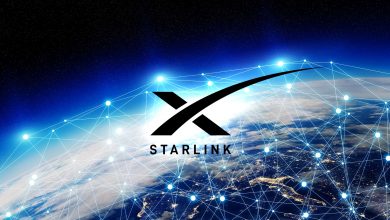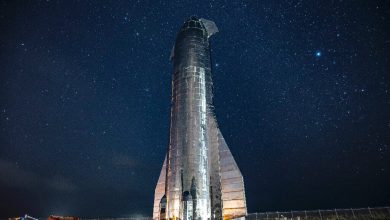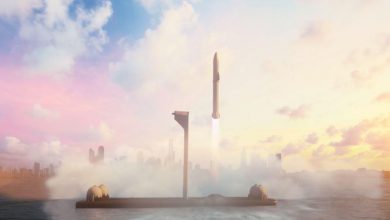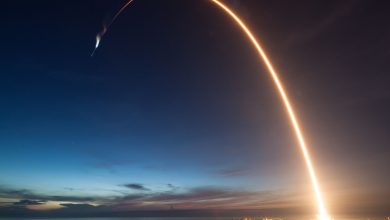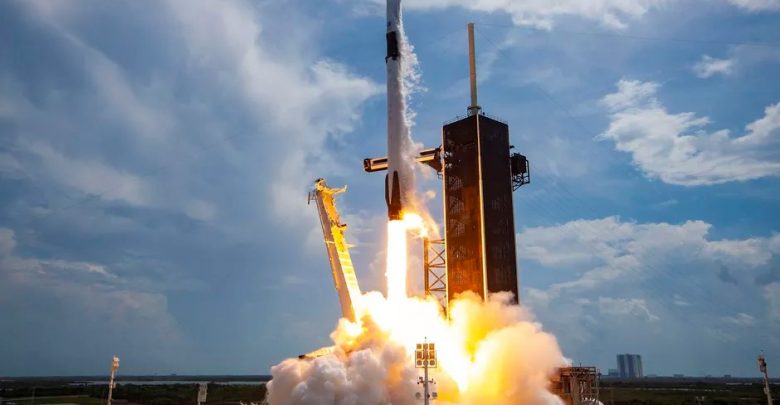
About a week ago, SpaceX launched 60 Starlink satellites using the Falcon 9 booster, but the unfortunate event happened. The booster failed to land on the oil rig converted into a launch pad.
A senior SpaceX official said this week that “heat damage” led to the failure of a Falcon 9 booster during a landing attempt Feb. 15, but the company will press on with more launches and will likely surpass the 10-flight threshold on one of its reusable rockets soon. The next Falcon 9 launch, using a booster flying on its eighth mission, is scheduled for liftoff from Florida with 60 more Starlink internet satellites Sunday night.
During a session of the 47th Spaceport Summit Feb. 23, Hans Koenigsmann, senior adviser for build and flight reliability at SpaceX, said the failed landing during an otherwise successful launch of Starlink satellites remains under investigation.
“This has to do with heat damage, but it’s a running investigation,” he said, adding that the company was “close to nailing it down” and correcting the problem. “That’s all I can say at this point in time.”
The failed landing broke a string of two dozen successful landings of Falcon 9 boosters, either on droneships or on land, dating back nearly a year. Video from the booster’s return showed that the engines did not shut down normally after the vehicle’s entry burn. The booster never made it to the droneship, and video from that ship showed a glow in the distance around the time the booster should have landed.
The investigation is of paramount importance, as SpaceX does not intend to launch any missions until it is sure what the reason for the failure was.
The mission launched from Space Launch Complex 40 (SLC-40) on the last 16th was a success, however, when it came to landing on the robotic raft dubbed “Of Course, I Still Love You”, the engines did not shut down as expected.
In a video of the return of the booster, it is possible to see that, in addition to the engines not having turned off after the entrance of the vehicle burned, the propellant never reached the vessel. In addition, it is possible to see a brightness in the distance when the landing should take place.
SpaceX hasn’t conducted a Falcon 9 launch since that failed landing. The next launch, of another set of Starlink satellites, is scheduled for no earlier than Feb. 28.
Other customers of the Falcon 9 are keeping tabs on the investigation. At a Feb. 19 briefing, Joel Montalbano, NASA International Space Station program manager, said the agency was in discussions with SpaceX about that investigation to see if it involved any issues that could affect the Crew-2 commercial crew launch scheduled for April 20. “As of today, we’re working with them to better understand what happened, and right now it’s just too early to say if we’re going to have any impacts” on that launch, he said.
Another government official saw no issues with the failed landing from a safety perspective. “This is what we call a successful failure,” said Wayne Monteith, associate administrator for commercial space transportation at the Federal Aviation Administration, during the Spaceport Summit panel discussion. “It failed within the safety regime and they protected the public and protected public property.”
“For us, even when a system does not meet all mission goals, as long as it fails safely, in many respects that’s progress,” he added. “Each of these flights demonstrates something new and allows industry to move forward.”
The booster that failed was on its sixth launch. SpaceX has flown boosters up to eight times each, and Koenigsmann said the company will launch a booster for a ninth time in a few weeks. SpaceX has set a goal of being able to fly each booster 10 times.
The landing failure occurred after 24 straight successful recoveries of SpaceX boosters since March 2020. SpaceX has recovered Falcon booster cores 74 times since 2015.
There was an unusual signature at the end of the Falcon 9 booster’s entry burn tonight, followed seconds later by the end of telemetry from the rocket.
The booster crashed in the Atlantic Ocean near SpaceX’s drone ship.https://t.co/iSV3bbx5ro pic.twitter.com/HqY06KmxiL
— Spaceflight Now (@SpaceflightNow) February 16, 2021
The booster flown on the Feb. 15 mission — designated B1059 — was on its sixth trip to space. SpaceX officials have said the most recent version of the Falcon 9 booster can make 10 flights with only inspections and minor refurbishment in between missions. With an overhaul, the Falcon 9 Block 5 boosters could fly 100 missions, SpaceX founder and CEO Elon Musk has said.
That is not a hard limit, though, Koenigsmann said. “We’re learning a lot about refurbishment and we’re learning where the areas are where we need to pay attention to,” he said, such as the booster’s heat shield and engine components. “We’ve been learning with every single landing.”
“We’ve learned a lot about refurbishment,” Koenigsmann stated. “We’re learning … what to pay attention to and maybe some of these are obvious. We want to take care of the heat shield. There are some engine components that need, on a regular basis, a degree of inspection to make sure the seals are working, and so on and so forth. So we’ve been learning with every single landing.”
SpaceX’s next launch, set for Sunday at 8:37 p.m. EST (0137 GMT Monday), will fly with a first stage booster known as B1049. This rocket will be making its eighth launch, tying another booster in SpaceX’s fleet for the most flights.
Koenigsmann said SpaceX will fly a booster on a ninth flight in a “few weeks.”
The 60 flat-panel Starlink satellites set for launch Sunday from NASA’s Kennedy Space Center will add to SpaceX’s fleet of more than 1,000 broadband relay stations in low Earth orbit. With the newest batch launching this weekend, SpaceX will have placed more than 1,200 Starlink satellites in orbit, including prototypes no longer in service.
SpaceX is moving closer to providing commercial internet service with the Starlink network, eyeing a commercial rollout later this year. The company is already providing connectivity to thousands of users on a test basis.
The Starlink network is driving SpaceX’s high tempo launch cadence. According to Koenigsmann, SpaceX will soon reach the 10-flight mark with one of its Falcon 9 boosters.
“I’m pretty sure we will get to 10 flights soon, and then we will continue to look at the booster and make an assessment (whether) we can move forward with it,” he said. “My personal opinion is that we will probably continue until we see more damage on the booster.”
Koenigsmann said SpaceX will look at data rather than specifying a certain number of flights for each booster.
“We will inspect them regularly, at regular intervals” he said. “And the next time you check that the engine held up and see if there’s any damage there. To me, it is an engineering problem. I don’t think the number of 10 is a magic number.
“Also, for example, we could start phasing in new components at some point in time and actually extend the life of the booster,” Koenigsmann said.
Koenigsmann said SpaceX is well-equipped for its projected flight rate from Florida’s Space Coast. Last year, SpaceX launched 26 Falcon 9 rockets, with 25 of those missions originating from Florida.
Musk has previously said the company aims to launch more than 40 Falcon 9 and Falcon Heavy missions in 2021. Most of the flights will again take off from SpaceX’s two launch pads at Cape Canaveral Space Force Station or at neighboring Kennedy Space Center.
“We have a pretty sweet set up right now,” Koenigsmann said. “We have two launch pads (in Florida). One of them is primarily useful for the crew … and the other one is mostly commercial launches and some of the other launches. In general, I feel we are pretty well set up for the current launch rate going forward.”
One area SpaceX is focusing on is infrastructure to move rockets between facilities at the spaceport — from the drone ship dock at Port Canaveral to a refurbishment facility at Cape Canaveral Space Force Station, then to one of the company’s two Florida launch pads.
“All of that activity will be increasing,” Koenigsmann said. “From the range’s side, I think it’s mostly deconflicting in terms of scheduling and making sure this can all be done safely. I feel like, from an infrastructure logistical point of view, we’re pretty much at a great spot right now. If the launch rate goes significantly higher, then we have to streamline the operations on the pad itself.”
The fastest turnaround for SpaceX launches from the same pad has been less than 10 days.
“Sometimes it boils down to crew rest,” Koenigsmann said.
The Space Force’s Eastern Range, which oversees launch operations at Cape Canaveral, has said it can accommodate two SpaceX launches within as little as five hours. The rapid turnaround between launches is primarily enabled by SpaceX’s use of an autonomous flight termination system on all of its Falcon 9 missions. The automated system replaces the more labor-intensive traditional human-in-the-loop flight termination systems, which are designed to destroy the rocket it it veers off course and threatens the public.
“We have not had a case that we will launch two vehicles on one single day, but we came very close,” he said. “I think … this will happen in the near future, that we launch two vehicles from two pads on the same day, and then it will only increase from there on.”

